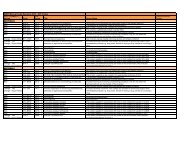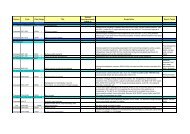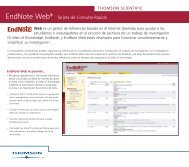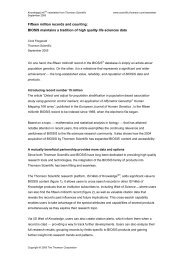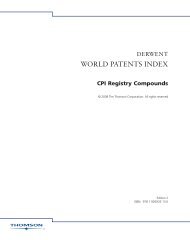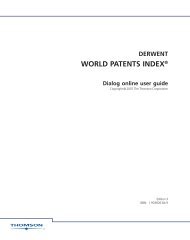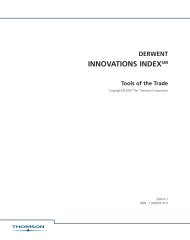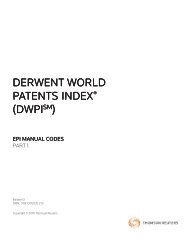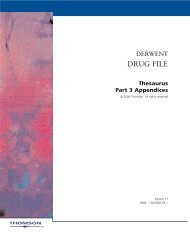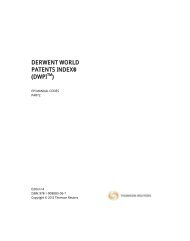Derwent World Patents Index (DWPI) - EPI ... - Thomson Reuters
Derwent World Patents Index (DWPI) - EPI ... - Thomson Reuters
Derwent World Patents Index (DWPI) - EPI ... - Thomson Reuters
Create successful ePaper yourself
Turn your PDF publications into a flip-book with our unique Google optimized e-Paper software.
Appendix 2: <strong>EPI</strong> Manual Coding Criteria<br />
<strong>EPI</strong> manual codes are normally assigned in two ways, namely:-<br />
1 To highlight the novel aspect of an invention itself<br />
2 To indicate significant application<br />
<strong>EPI</strong> Manual Codes 2011 1213<br />
Part 3<br />
In the first case, codes will usually be assigned based on the content of the patent claims. In the second<br />
case, applications may be derived from either the claims or the wider disclosure of the specification.<br />
The following general points should be noted regarding the assignment of <strong>EPI</strong> codes:-<br />
1 A patent may be selected for inclusion in <strong>EPI</strong> based on its intended use only, the actual novel<br />
aspect being outside the scope of <strong>EPI</strong> codes. For example, the invention may relate to a novel chemical<br />
compound of relevance to an electrical or electronic industry, such as a polymer composition intended as a<br />
magnetic tape substrate. In such a case, only the application aspect can be conveyed by <strong>EPI</strong> codes.<br />
2 Where an invention has no stated application, is of universal application, or a series of<br />
applications is given which are merely standard uses for such a device, manual codes are usually assigned<br />
to describe only the invention itself. Examples of this include a common electronic component such as a<br />
capacitor, or a battery of a type used in a wide variety of portable devices. However, significant electrical<br />
applications which are emphasised, or are one among several non-electrical applications, will be coded.<br />
3 <strong>EPI</strong> manual codes are hierarchical in structure, such that an increase in the number of characters<br />
represents a finer subject breakdown. This means that in cases where the precise details of an invention<br />
cannot be determined with certainty, or where several code subdivisions are equally applicable, a general<br />
manual code may be assigned. A more general code is also assigned if an appropriate sub-division code<br />
does not exist. Thus, when formulating a search, users are advised to consider the inclusion of a more<br />
general code in addition to finer subdivisions which are known to be relevant.<br />
4 In many areas of the <strong>EPI</strong> coding system, in addition to codes for a product, separate subdivision<br />
codes are provided to represent materials used in the product, their manufacture, and manufacture of the<br />
product itself. Note that in general, the manufacture of materials used in a product is not coded as<br />
manufacture of the product unless it is one of a number of steps in a process for manufacturing the<br />
product as a whole. Thus, manufacture of a polymer material which can be used as a magnetic tape<br />
substrate is coded as a tape substrate. Subsequent processing of the material, such as cutting or shaping<br />
to form the actual substrate, is coded as substrate manufacture.<br />
5 As explained in Appendix 1, patents are included in <strong>EPI</strong> either by virtue of patent office-assigned<br />
IPC or by an intellectual selection process. Irrespective of the initial route by which the invention is<br />
included, the same intellectual criteria are used to assign manual codes. However, it should be noted that<br />
the requirements for electrical content differ between <strong>EPI</strong> classes since, as explained in Appendix 1, some<br />
inventions are included<br />
electrical aspect. For example, a patent in the field of instrumentation or control, included only on the<br />
basis of its IPC, cannot be assigned for an application in X25 (industrial equipment) since the electrical<br />
content requirements for that class are not satisfied. Conversely, an invention selected for X25 based on its<br />
electrical content can be coded for any significant control or instrumentation content where relevant.



